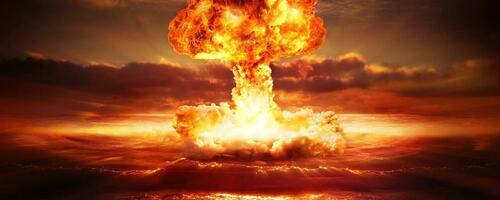US-Russia Nuclear War Would Kill 5 Billion From Famine Alone: Study
If tensions between Russia and the United States spark an all-out nuclear war between the two rivals, more than five billion people would die from hunger alone, according to a new study in the journal Nature Food.
Scientists at Rutgers University projected the amount of soot that would be thrust into the Earth’s atmosphere in a variety of nuclear war scenarios, from smaller exchanges between India and Pakistan to a full-blown war between Russia and the United States.
A relatively modest Indo-Pakistani war would slash the world’s average caloric output by 7% within the first five years — bigger than any disruption humanity has faced thus far. “Even for a regional nuclear war, large parts of the world may suffer famine,” say the study’s authors.
The biggest US-Russian exchange would positively devastate global food production — shrinking it 90% within three to four years after the explosions cease, the researchers say. Seventy-five percent of human beings would be dead in two years.
In addition to lower crop yields, the Rutgers model attempted to account for export restrictions, as well as mitigation efforts such as giving humans livestock feed to eat.
As devastating a picture as the study presents, it’s understated. “The ozone layer would be destroyed by the heating of the stratosphere, producing more ultraviolet radiation at the surface, and we need to understand that impact on food supplies,” Rutgers assistant research professor Lili Zia tells Sky News. Researchers also didn’t factor in changes in fertilizer and food supplies, which would be substantial.
Noting that crises “with nuclear undertones are festering,” earlier this month, United Nations Secretary-General Antonio Guterres warned that mankind is “just one misunderstanding away from nuclear annihilation.”
In the immediate aftermath of Russia’s February invasion of Ukraine, President Vladimir Putin said he’d ordered his nuclear forces into “special combat readiness.”
Amid all the talk about Russia, let’s not forget about heightened tensions between the United States and another nuclear power. As The New York Times reported in June:
Last summer, hundreds of new missile silos began appearing in the Chinese desert. The Pentagon declared that Beijing, which had long said it needed only a “minimum deterrent,” was moving to build an arsenal of “at least” 1,000 nuclear arms by 2030.
Meanwhile, just when things were quieting down after House Speaker Nancy Pelosi’s visit to Taiwan, a previously-unannounced delegation of five more pathetic, attention-seeking legislators arrived on the island on Sunday. That provoked more Chinese anger and another round of military drills near Taiwan.
Against the Rutgers study’s generally horrific backdrop, one country stood out as faring far better than others: Australia’s caloric output showed only small reductions or even an increase. Don’t get excited, Aussies: The researchers said you’d be besieged by refugees from Asia. You may be wishing you had a few more rifles, shotguns and pistols laying around.
Tyler Durden
Wed, 08/17/2022 – 04:15

